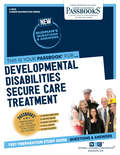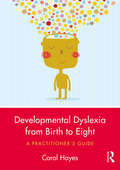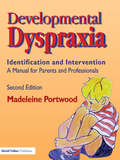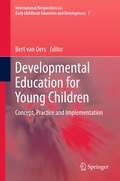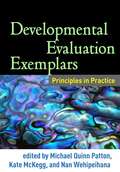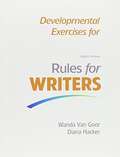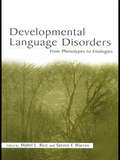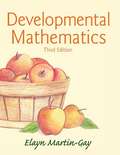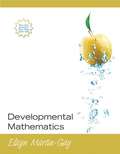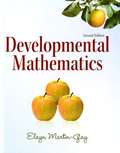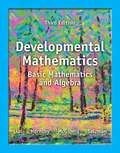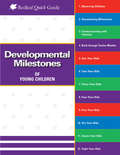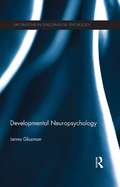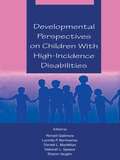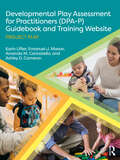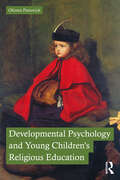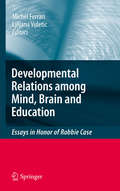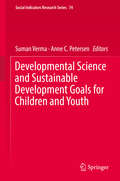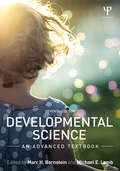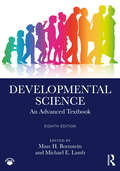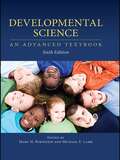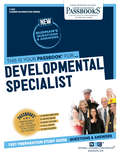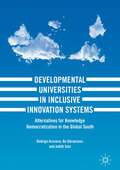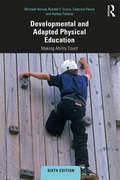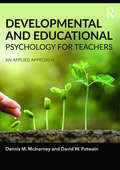- Table View
- List View
Developmental Disabilities Secure Care Treatment Aide: Passbooks Study Guide (Career Examination Series)
by National Learning CorporationThe Developmental Disabilities Secure Care Treatment Aide Passbook® prepares you for your test by allowing you to take practice exams in the subjects you need to study. It provides hundreds of questions and answers in the areas that will likely be covered on your upcoming exam, including but not limited to; Dealing with daily situations in an OMH/OMRDD setting; Observing and recording situations of daily living; Understanding and applying written instructional material; Arithmetic for daily living; and more.
Developmental Dyslexia from Birth to Eight: A Practitioner’s Guide
by Carol HayesDevelopmental Dyslexia from Birth to Eight takes a fresh approach to a condition which is often poorly understood and unjustly stigmatised. Illuminating the latest neurological advances in the field, this book will empower educational professionals to play a decisive role in supporting and encouraging children with dyslexia. With an overarching focus on the ways in which practitioners can advance children’s development and learning, Developmental Dyslexia from Birth to Eight recognises the varying guises in which this information-processing difference might present, and addresses the challenges that this creates for children and practitioners alike. Each chapter provides the reader with a thorough examination and explanation of dyslexia, along with reflective examples, case studies and relevant further reading. Areas of focus include: The origins and identification of dyslexia Intervention strategies and alternative therapies Observation and assessment Dyslexia and English as a foreign language Dyslexia-friendly settings National and global policy on provision for dyslexic children An engaging and accessible guide, this book will be an invaluable resource for educational practitioners and childcare specialists seeking to enhance their knowledge and understanding of dyslexia, to better support the children in their care.
Developmental Dyspraxia: Identification and Intervention: A Manual for Parents and Professionals
by Madeleine PortwoodFirst published in 2007. Research suggests that between five and ten per cent of all children are dyspraxic. There is much debate about the nature of this disorder and many undiagnosed youngsters are denied access to treatment programmes. In most areas specialist provision is a scarce resource and support, when available, is delivered through parents and teachers. This second edition of Madeleine Portwood's successful manual aims to give parents, teachers and health professionals the confidence to diagnose and assess dyspraxia. Most importantly. it offers them an intervention programme which will significantly improve the cognitive functioning of the dyspraxic child or teenager. Updated in light of the author's new and extensive research, the book provides the reader with: background information on the neurological basis of the condition; strategies for identification/diagnosis and assessment; proven programmes of intervention which can be monitored by anyone closely involved with the child; strategies to improve curricular attainments; remediation activities to develop perceptual and motor skills; programmes to develop self-esteem information about where to find help
Developmental Education for Young Children: Concept, Practice and Implementation
by Bert Van OersDevelopmental Education is an approach to education in school that aims at promoting children's cultural development and their abilities to participate autonomously and well-informed in the cultural practices of their community. From the point of view of Cultural-historical Activity theory (CHAT), a play-based curriculum has been developed over the past decades for primary school, which presents activity contexts for pupils in the classroom that create learning and teaching opportunities for helping pupils with appropriating cultural knowledge, skills, and moral understandings in meaningful ways. The approach is implemented in numerous Dutch primary schools classrooms with the explicit intention to support the learning of both pupils and teachers. The book focuses especially on education of young children (4 - 8 years old) in primary school and presents the underpinning concepts of this approach, and chapters on examples of good practices in a variety of subject matter areas, such as literacy (vocabulary acquisition, reading, writing), mathematics, and arts. Successful implementation of Developmental Education in the classroom strongly depends on dynamic assessment and continuous observations of young pupils' development. Strategies for implementation of both the teaching practices and assessment strategies are discussed in detail in the book.
Developmental Evaluation Exemplars
by Michael Quinn Patton Nan Wehipeihana Kate MckeggResponding to evaluator and instructor demand, this book presents a diverse set of high-quality developmental evaluation (DE) case studies. Twelve insightful exemplars illustrate how DE is used to evaluate innovative initiatives in complex, dynamic environments, including a range of fields and international settings. Written by leading practitioners, chapters offer a rare window into what it takes to do DE, what roles must be fulfilled, and what results can be expected. Each case opens with an incisive introduction by the editors. The book also addresses frequently asked questions about DE, synthesizes key themes and lessons learned from the exemplars, and identifies eight essential principles of DE. See also Michael Quinn Patton's Developmental Evaluation, the authoritative presentation of DE.
Developmental Exercises For Rules For Writers
by Diana Hacker Nancy SommersTo learn any skill--whether snowboarding, tennis, CPR, Web design, or the electric guitar--takes practice. Writing well is no exception: In a college composition class, you will learn to write by writing, and you will learn to revise by revising. Developmental Exercises for Rules for Writers, Eighth Edition, will sharpen your revision skills by giving you a great deal of controlled, yet realistic, practice.
Developmental Language Disorders: From Phenotypes to Etiologies
by Mabel L. Rice Steven F. WarrenDevelopmental Language Disorders: From Phenotypes to Etiologies is based on the recent conference of the same name sponsored by the Merrill Advanced Studies Center of the University of Kansas. In the past 10 years, considerable advances have taken place in our understanding of genetic and environmental influences on language disorders in children. Significant research in behavioral phenotypes, associated neurocortical processes, and the genetics of language disorders has laid the foundation for further breakthroughs in understanding the reasons for overlapping etiologies, as well as the unique aspects of some phenotypes. Too often the findings are disseminated in a fragmented way because of the discrete diagnostic categories of affectedness. This volume attempts to assimilate and integrate the findings of the transdisciplinary research toward a more coherent picture of behavioral descriptions, brain imaging studies, genetics, and intervention technologies in language impairment. The contributing authors are all scholars with active programs of research funded by the National Institutes of Health involving diverse clinical groups of children with language impairments.
Developmental Mathematics
by Elayn Martin-GayElayn Martin-Gay's developmental math program is motivated by her firm belief that every student can succeed. Martin-Gay's focus on the student shapes her clear, accessible writing, inspires her constant pedagogical innovations, and contributes to the popularity and effectiveness of her video resources. This revision of Martin-Gay's algebra series continues her focus on students and what they need to be successful. This program provides a better teaching and learning experience, for you and your students. Here's how: The new Martin-Gay Student Success Program provides an integrated teaching and learning system--combining the textbook, MyMathLab®, student and video organizers, and the video program--which is designed to help students gain the math and study skills they need for success in developmental math and beyond.
Developmental Mathematics
by K. Elayn Martin-GayDevelopmental Mathematics is a new addition to the Martin-Gay work text series and is intended for a 2-3 semester sequence of Basic Math,Introductory Algebra and Intermediate Algebra. The text provides complete coverage for basic mathematics and introductory algebra courses and with the appendices ("further topics in algebra") it provides the necessary intermediate algebra topics. The Whole Numbers; Multiplying and Dividing Fractions; Adding and Subtracting Fractions; Decimals; Per¢ Geometry; Statistics and Probability; Real Numbers and Introduction to Algebra; Equations, Inequalities, and Problem Solving; Graphing Equations and Inequalities; Systems of Linear Equations; Exponents and Polynomials; Factoring Polynomials; Rational Expressions; Roots and Radicals; Quadratic Equations and Nonlinear Graphs; Further Algebraic Topics; Tables; The Bigger Picture; Further Geometric Topics; Inductive and Deductive Reasoning; Sample THEA Test For all readers interested in developmental mathematics.
Developmental Mathematics (Second Edition)
by Elayn Martin-GayElayn Martin-Gay firmly believes that every student can succeed, and her developmental math textbooks and video resources are motivated by this belief. Developmental Mathematics, Second Edition was written to help readers effectively make the transition from arithmetic to algebra. The new edition offers new resources like the Student Organizer and now includes Student Resources in the back of the book to help students on their quest for success.
Developmental Mathematics: Basic Mathematics And Algebra
by Margaret L. Lial John Hornsby Stanley Salzman Diana Hestwood Terry McGinnisThe Lial Series has helped thousands of students succeed in developmental mathematics by providing the best learning and teaching support to students and instructors.
Developmental Milestones of Young Children
by Karen PettyDevelopmental milestones mark the significant progress children make throughout their early years. This Redleaf Quick Guide includes descriptions of the typical physical, social, emotional, language, and cognitive milestones that infants, toddlers, preschoolers, and early elementary-age children reach. It also includes strategies for observing, recording, and communicating milestones to families.
Developmental Neuropsychology (Explorations in Developmental Psychology)
by Janna GlozmanDevelopmental Neuropsychology draws upon the research of Alexander Luria and Lev Vygotsky to present a comprehensive study of developmental neuropsychology from a Russian, and Western perspective. Janna Glozman offers a fresh and accessible analysis of Luria and Vygotsky’s collaboration, which greatly influenced the field of neuropsychology as we know it today. The text provides an examination of theoretical and methodological foundations of developmental neuropsychology, which Glozman describes and systemizes, before providing methods of assessment and neuropsychological aspects of specific situations. In her work Glozman considers: abnormal social mechanisms methods of assessment and remediation historical developments specific disabilities including dyslexia, ADHD and autism Glozman’s comparative text makes Russian developmental psychology practically accessible to a western audience. It is valuable reading for researchers in developmental and clinical psychology, as well as professionals in special education, speech therapy and social work.
Developmental Perspectives on Children With High-incidence Disabilities (The LEA Series on Special Education and Disability)
by Sharon Vaughn Ronald Gallimore Lucinda P. Bernheimer Donald L. MacMillan Deborah L. SpeeceThis volume has two purposes. The first is to summarize, substantiate, and extend current knowledge on the development of children with high incidence disabilities--most notably, learning disabilities, behavioral disorders, and mild mental retardation. The second is to honor the career of Professor Barbara K. Keogh and her contributions to the developmental study of children with high incidence disabilities. Internationally recognized for her accomplishments, Keogh is esteemed for her originality and clarity of thought. For nearly forty years, she has set an extraordinary model of analytic rigor combined with a kind and generous manner that inspires, supports, and sets an exacting standard of scholarship. The contributing authors to this volume represent only a fraction of the students and scholars touched by her distinguished career. In conceiving this volume, the editors sought to represent the topics, problems, and issues to which Keogh has devoted herself. They invited chapters that summarize what is known about the high incidence handicapping conditions that her research has mainly addressed and sought to reflect the probing, questioning style that she brings to her own work. Researchers, policymakers, and graduate students in special education and associated disciplines who seek to stay current will find this volume crucial reading.
Developmental Play Assessment for Practitioners (DPA-P) Guidebook and Training Website: Project Play
by Karin Lifter Emanuel J. Mason Amanda M. Cannarella Ashley D. CameronDevelopmental Play Assessment for Practitioners (DPA-P) Guidebook and Training Website: Project Play offers a comprehensive assessment of naturally occurring play activities for evaluating young children’s developmental progress accurately, so that useful interventions can take place as early as possible. It can be used by practitioners in a wide range of educational and therapeutic settings and is designed to support developmental progress through planning interventions in play, and using what we know about a child’s progress in play to plan play-based interventions in cognition, language, motor, social-emotional, and self-help skills. The guidebook and training website provide a comprehensive introduction to how to successfully use the assessment with infants, toddlers, and young children with disabilities or at risk for disabilities. The comprehensive guidebook offers an overview of the DPA-P and Project Play, defines play, discusses the background literature on play, and explains why this assessment is needed. Clear guidance helps practitioners and family members understand play, how to evaluate play, and how to use play for different purposes. The guidebook offers: an introduction to the comprehensive training website and how to use it understanding of the categories of play assessed and their definitions guidance on how to administer the assessment and prepare a summary evaluation of a child’s performance clear instructions for the coding sheets and scoring guidelines for constructing sets of toys guidance on taking the results of the DPA-P evaluation of a child’s progress in play to develop a plan of activities for intervention explanation of how you evaluate activities at the absence, basic, emergence, and mastery levels for developing a plan suggestions for assembling sets of toys for intervention, based on toys available in children’s homes and early childhood settings procedures for facilitating or teaching play activities to children who are developing more slowly than their peers technical aspects of the assessment To make the DPA-P as flexible as possible for all practitioners, it also offers guidance on adaptations for administering the test, in the coding sheets, with toys to enhance cultural appropriateness for gathering the observations, and for supporting interventions in play. The Developmental Play Assessment for Practitioners (DPA-P) can be used in natural settings and takes 30 minutes to complete. It is a valuable tool for all those who serve, or are training to serve, young children in early childhood settings, schools, service agencies, colleges, and universities. It will be of great benefit for early intervention personnel, speech-language pathologists, physical therapists, occupational therapists, and psychologists.
Developmental Psychology and Young Children’s Religious Education
by Olivera PetrovichDevelopmental Psychology and Young Children’s Religious Education sets out to identify the conceptual pre-requisites for young children’s religious education learning and clearly highlights the challenges that children and their teachers encounter in the RE educational process. Based on a study with 431 children aged 5 to 7 years from different schools, faith and non-faith, and 47 teachers from the same schools as the children, this book offers an insightful look into younger children’s religious education, providing statistical evidence to dismantle the belief that young children lack the ability to conceptualise God in abstract terms. The information obtained from these children and their teachers reveals a major discrepancy between the teachers’ perceptions of young children’s conceptual abilities for RE learning, on the one hand, and children’s actual abilities revealed in their responses throughout the study, on the other. Based on the evidence described in the volume, Petrovich argues that teacher-training courses for primary RE need to be designed to include a substantial component of contemporary developmental research that is of direct relevance to children’s conceptual abilities and understanding of abstract concepts. Developmental Psychology and Young Children’s Religious Education is essential reading for students and researchers in developmental psychology, religious education, teacher education, education studies and cultural anthropology.
Developmental Relations among Mind, Brain and Education
by Michel Ferrari Ljiljana VuleticThis book serves a dual purpose: it is both a tribute to the legacy of Robbie Case, a great Developmental Psychologist who died prematurely in 2001, and it presents cutting edge research and theory that explores the developmental relations between mind, brain, and education, an emerging field that now has its own international society (IMBES) and its own Journal of Mind Brain and Education. The integration of research on the developmental relations between mind, brain and education is one that Robbie Case helped pioneer, and the chapters in this volume by his students and colleagues in areas as far-ranging as science education, parenting, bullying, and personal development show it to be extremely fruitful. The chapters in the volume are written in style make them accessible to teachers and students interested in relations between neuroscience, cognitive science, and education, and contain a wealth of detail that experts will find informative. We hope the volume will provide a resource that shows what has been accomplished and the exciting work that remains to be done in this emerging field studying the developmental relations between mind, brain, and education.
Developmental Science and Sustainable Development Goals for Children and Youth (Social Indicators Research Series #74)
by Anne C. Petersen Suman VermaThis book presents new scientific knowledge on using developmental science to improving lives of children and youth across the globe. It highlights emerging pathways to sustainability as well as the interconnectedness and interdependence of developmental science and sustainable children and youth development globally. Presenting cross-cultural views and current perspectives on the role of developmental science in the realization of the Sustainable Development Goals for children and youth development, contributors from different disciplines from low-and-middle-income countries or scholars working in these countries capture ground realities of the situation of children and youth in these regions. This book addresses developmental issues related to inequity, gender, health, education, social protection, and needs of vulnerable populations of children and youth. Other areas of focus are improving mechanisms and monitoring frameworks of development and well-being indicators.
Developmental Science: An Advanced Textbook
by Marc H. Bornstein Michael E. LambDevelopmental Science: An Advanced Textbook is the most complete and cutting-edge introduction to the field available today. Since its initial publication, the key purpose of the text has been to furnish inclusive developmental perspectives on all substantive areas in psychology--neuroscience, perception, cognition, language, emotion, and social interaction. This edition is no exception, as it continues to underscore the dynamic and exciting status of contemporary developmental science. In this Seventh Edition, Marc H. Bornstein and Michael E. Lamb once again invite international experts to prepare original, comprehensive, and topical treatments of the major areas of developmental science, which are masterfully woven into a single coherent volume. Some chapters in this edition are new, and those carried forward from the sixth edition have been extensively revised. This volume represents faithfully the current status of scholarly efforts in all aspects of developmental science. Ideal for advanced undergraduate and introductory graduate courses, the text is accompanied by a website with supplementary material for students and instructors, including chapter outlines, topics to think about before reading, glossaries, and suggested readings.
Developmental Science: An Advanced Textbook
by Marc H. Bornstein Michael E. LambDevelopmental Science: An Advanced Textbook is the most complete and up-to-date advanced introduction to the field available today. Since its initial publication, the key purpose of this advanced textbook has been to furnish inclusive developmental perspectives on all theoretical, methodological, and substantive areas in developmental science. This eighth edition is no exception, as it continues to underscore the dynamic and exciting status of contemporary developmental science.In this eighth edition, Marc H. Bornstein and Michael E. Lamb have invited international experts to prepare original, comprehensive, and topical treatments of all major areas of developmental science; they are masterfully woven into a single coherent volume. The substantive chapters cover essentials of their main topics, with close attention paid to cultural, lifespan, and applied perspectives. Many chapters in this eighth edition are new, and those carried forward from the seventh edition have been extensively revised. This volume therefore represents faithfully the current status of scholarly efforts in all aspects of developmental science.Ideal for advanced undergraduate and introductory graduate courses, this advanced textbook is accompanied by two sets of supplementary materials: pedagogy files for students include chapter outlines, things to think about before reading the chapters, glossaries, and suggested readings; and ancillary files for instructors include a PowerPoint deck of tables and figures, classroom assignments, essay questions, multiple-choice questions, and short-answer questions.
Developmental Science: An Advanced Textbook, Sixth Edition
by Marc H. Bornstein Michael E. LambNoted as one of the most comprehensive textbooks in the field, Developmental Science, 6th Edition introduces readers to all of areas in developmental psychology: neuroscience, genetics, perception, cognition, language, emotion, self, and social interaction. Each of the world-renowned contributors masterfully introduces the history and systems, methodologies, and measurement and analytic techniques used to understand the area of human development under review. The relevance of the field is illustrated through engaging applications in each chapter. As a whole, this highly-respected text illuminates substantive phenomena in developmental science, its applications across the life span, and its relevance to everyday life. Each chapter has been substantially revised for this new edition to reflect the current state of the field and the new edition is now accompanied by a website. Students and instructors will find chapter outlines, topics to think about before reading the chapters, a glossary, and suggested readings with active reference links on the website. Electronic access to the text's figures and tables, suggestions for classroom assignments and/or discussion, and a test bank with multiple-choice, short answer, and essay questions is limited to instructors only. Two new chapters highlight many modern developments. Each chapter features an introduction, up-to-date overviews of the field, summary and conclusion, and numerous classical and contemporary references. The book opens with an overview of developmental science -- its history and theory, the cultural orientation to thinking about human development, and the manner in which empirical research is designed, conducted, and analyzed. Part 2 focuses on the field's major substantive areas: neuroscience and genetics, physical and motor skills, perception, and cognitive and language development. Part 3 examines personality and social development within the context of the various relationships and situations in which developing individuals function and by which they are shaped. The book concludes with a new chapter on the latest applications of developmental science. Ways in which developmental thinking and research affect and are affected by practice and social policy are particularly emphasized. Used primarily as a graduate level text for courses on developmental psychology/science, life span, and/or human development, the book can also be used at the advanced undergraduate level. Researchers interested in staying abreast of the latest developments in the field also appreciate the book's comprehensive nature.
Developmental Specialist: Passbooks Study Guide (Career Examination Series #C-923)
by National Learning CorporationThe Developmental Specialist Passbook® prepares you for your test by allowing you to take practice exams in the subjects you need to study. It provides hundreds of questions and answers in the areas that will likely be covered on your upcoming exam, including but not limited to: developing and implementing habilitation plans; interpreting and maintaining client records; understanding individuals with developmental disabilities; and more.
Developmental Universities in Inclusive Innovation Systems
by Bo Göransson Rodrigo Arocena Judith SutzThis book analyzes the current trends in the production, dissemination, and use of knowledge which contribute to social inequalities, especially in the Global South. The aim of the text is to explore the possibilities of active involvement by universities in the democratization of knowledge - a process by which people will be able to more easily acquire and utilize knowledge, as well as the results and benefits of research and development. Combining higher education, research, and knowledge utilization is what universities should be doing. When they efficiently contribute to overcoming inequality and underdevelopment, they may be considered developmental universities. They should not function in solitude with privileged elites alone, but in the context of "inclusive innovation systems. "
Developmental and Adapted Physical Education: Making Ability Count
by Michael Horvat Ronald V. Croce Caterina Pesce Ashley Eason FallaizeNow in a fully revised and updated 6th edition, reflecting changes in legislation and cutting-edge research, this is a complete introduction to adapted physical education, from the underpinning science to practical teaching strategies and program design. The book covers a broader range of disabilities, developmental disorders, and health conditions than any other textbook and includes brand new material on developmental coordination disorders and cognitive development. Full of teaching and coaching strategies and techniques, it introduces scientific fundamentals, key legislation, and best practice in designing effective programs. It encourages the reader to consider the individual before the disability and to focus on what learners can do rather than what they can’t. This is an essential reference for teachers, coaches, or exercise professionals working with children with disabilities. It is also an invaluable resource for undergraduate or postgraduate students of adapted physical education, kinesiology, physical education, physical therapy, exercise science, athletic training, or sports coaching. The new edition features updated online resources, including PowerPoint slides, web links, an example syllabus, and quizzes.
Developmental and Educational Psychology for Teachers: An applied approach
by Dennis McInerney David PutwainDevelopmental and Educational Psychology for Teachers brings together a range of evidence drawn from psychology to answer a number of critical educational questions, from basic questions of readiness – for example, when is a child ready for school, through to more complex matters, such as how does a teacher understand and promote good peer relationships in their classroom? The answers to these and other questions discussed draw here on the interplay between a teachers’ craft expertise and their knowledge of evidence and theory from developmental and educational psychology. Presenting a range of classic theories and contemporary research to help readers understand what the key issues are for teachers and other professionals, this book aides informed educational decisions in situations such as: inclusion, ability grouping, sex differences, developing creativity, home and peer influences on learning, and developing effective learners. Teachers in early years, primary and secondary settings are routinely faced with questions regarding the development of children. This not only relates to the planning and delivery of lessons, but also to the mental and physical wellbeing of the children and adolescents that they teach. The pedagogical features of this book are accessible and clearly presented, including focus questions that direct the reader’s attention to key issues, activity posts that point the reader to meaningful and relevant research and show the practical applications of material covered, and extension material that gives depth to many of the topics covered. This book aims to inform the practice of both in-service and trainee teachers, addressing issues that are relevant to their practice. With no other detailed and accessible text presenting this evidence and theory specifically for an audience of practicing and trainee teachers currently on the market, this book will be of essential reading to practicing and trainee teachers for early years, primary and secondary education and other related educational contexts such as educational psychologists, counsellors, paediatric and child doctors and nurses.
